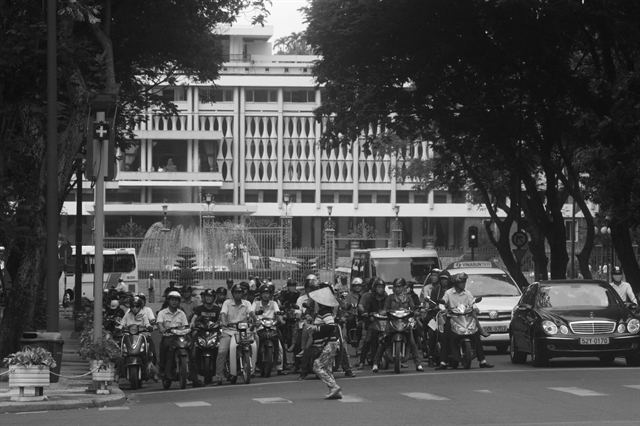 Life & Style
Life & Style

 |
by Ray Riches*
Staring at the perfect imperfection of a photo of a street market in HCM City, it is evident that there is a style in the city that only photos can express. Taking inspiration from Alex Garel, who has been capturing this city for over a decade, there is a deep brilliance to modern HCM City that joins the past and present as one.
In the cold suburbs of Sydney, Australia, a young boy climbs up on a chair to reach a box of slides on top of a cupboard. It is 1976, the war in Việt Nam is over, and Sài Gòn has been renamed HCM City in honour of their leader, Hồ Chí Minh.
The box of slides contains around 160 film squares encased in white cardboard. They go into a projector that illuminates them, like a cinema, on a screen or white wall. Those photos are a collection of images of Sài Gòn and Biên Hòa in 1966, which were taken by the boy's father, who spent one year in Việt Nam as a part of the allied forces.
Those pictures captured a bland and distant view of life in these regions during wartime, and they were strangely normal. Wide open spaces and distant figures of people going about their day as a conflict developed across their country.
Rather than bore this young boy, they switched on his dreams. Each pixel of each photo had something more behind it, and the dream was to find that deep vision of the community by experiencing it and capturing it in a modern, digital form.
This is where Alex Garel’s photo book Saigon: Portrait of a City hits a deep space in that young boy’s heart, who is now some 50 years older. However, Garel's motivation comes not from wartime slides, but from a love of architecture and how HCM City has French buildings that are truly unique in style and character.
The son of an architect, Garel arrived in Việt Nam over a decade ago. Rather than focus on the global icons of Việt Nam that are found in every pictorial representation, he took his father’s architectural inspiration and began recording the complex structures in HCM City that reflected the conflicting cultures of modern Việt Nam with the influence of past French occupation.
 |
The book, with its vibrant and detailed images, tells a different story of HCM City — not in words, but through the camera lens. It depicts how the city went from a fledgling Sài Gòn and, over 100 years, found this unique mix of modernity and a rigid preservation of its past history.
Garel says that his motivation is to preserve the memories of HCM City, but after looking at the book, it could also be suggested that it’s honouring his father’s influence by capturing the city in a very different way to that of any other photographer. It really tells its own historical story in every photo.
It’s true that some of the buildings in his photos taken around 2011 to 2013 are no longer standing, and this makes his book even more enjoyable. Change has been rapid in HCM City over the past decade or so, and the victim of this modernisation has been some of the old buildings that held so much character and history. These buildings are now only a memory — and fortunately, a photo — thanks to the passion of Garel.
There is a covert significance to people producing books like this. They are not made for profit because there is exceptional selection in the digital age. But the digital age brings with it a sense of demand and 'the now', which, ironically, places content in the recycle bin just as quickly as it is produced. This results in amazing content, such as the photos of Alex Garel, becoming forgotten memories just as fast as they are created.
Books like Saigon: Portrait of a City lock in a time and a memory for generations to come. They bring the reader to a specific time and place and take them on a journey made up of moments worth remembering. They allow the reader to slow down, immerse themselves in the beauty of these moments in history and give them time to learn just a little about an era otherwise forgotten.
And just like Alex, that young boy from Sydney, Australia arrived in Việt Nam around a decade ago, bought a camera and began his own journey of capturing the spirit of this amazing city. In his case, it was not the beauty of the French architecture that motivated him, but the faces and character of the community that were the heart and soul of Việt Nam.
While progress and change are inevitable, there comes with it a sadness of a time past that is forever lost to future generations. But with the passion of photographers and the motivation to create amazing books, the past can be there for generations to come.
I have relished in the memories and romantic detail of the photos in Alex’s book, but I also carry in my own heart a memory of Việt Nam. That memory started with black and white slides in the 1970s and continues today, more than 50 years later. Whether it is Sài Gòn or HCM City, it is a deeply enriching and stunning city that seems to offer you just what you need — and in some of the most unexpected ways.
*Ray Riches lives in HCM City and works as a teacher and freelancer. He is also a bicycle rider with experiences across Việt Nam. With more than ten years in HCM City, Ray enjoys sharing his unique experiences of Việt Nam with people all over the world.




